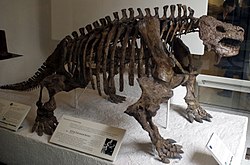| Pareiasauria Temporal range: Middle Permian - Late Permian,
| |
|---|---|

| |
| Skeleton of Scutosaurus karpinskii in the American Museum of Natural History | |
| Scientific classification | |
| Domain: | Eukaryota |
| Kingdom: | Animalia |
| Phylum: | Chordata |
| Class: | Reptilia |
| Clade: | †Parareptilia |
| Order: | †Procolophonomorpha |
| Node: | †Ankyramorpha |
| Suborder: | †Procolophonia |
| Clade: | †Pareiasauromorpha |
| Superfamily: | †Pareiasauroidea |
| Clade: | †Pareiasauria Seeley, 1888 |
| Genera | |
| |
Pareiasaurs (meaning "cheek lizards") are an extinct clade of large, herbivorous parareptiles. Members of the group were armoured with osteoderms which covered large areas of the body. They first appeared in southern Pangea during the Middle Permian, before becoming globally distributed during the Late Permian. Pareiasaurs were the largest reptiles of the Permian, reaching sizes equivalent to those of contemporary therapsids. Pareiasaurs became extinct in the Permian–Triassic extinction event.